Multiples of 7 – All the Multiples of 7 up to 1000
Have you ever wondered what multiples of 7 are and how they are calculated? The multiples of 7 between 1 and 100 include 7, 14, 21, 28, 35, 42, 49, 56, 63, 70, 77, 84, 91, and 98. And the operation of multiples is fundamental in math, and knowing the multiples of 7 can help you solve applications from basic arithmetic to more complex math problems!
Multiples of 7 are those integers that have no remainder after division by 7. To obtain multiples of 7, you can keep adding or multiplying 7 with natural numbers. The first five multiples of 7 include 7, 14, 21, 28, and 35, while the prime factorization of 7 is 7 itself.
In this article, we will explore all the information about multiples of 7, provide examples of solutions along with free worksheets about multiplication by 7. Let’s learn more about multiples of 7 in the tabular form with examples. Scroll down to find out more.

What are Multiples of 7?
Multiples of 7 are numbers that do not leave a remainder when divided by 7. In other words, if a number is divisible by 7 and the result is a whole number, it is a multiple of 7. There is an infinite number of multiples of 7 because you can keep multiplying 7 by any integer. Formally, multiples of 7 can be expressed as: 7 x n, where n is any integer, including positive integers, negative integers, or zero.
These numbers are obtained by multiplying 7 by the integers from 1 to 14. Each multiple represents a value that is divisible by 7 within this range. So some multiples of 7 include:
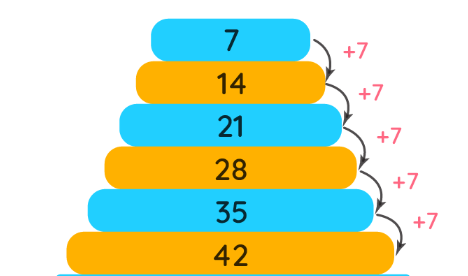
List of Multiples of 7
The following table lists 20 infinite multiples of 7 by multiplication:
| Multiplication | Multiples of 7 |
|---|---|
| 7 x 1 | 7 |
| 7 x 7 | 14 |
| 7 x 3 | 21 |
| 7 x 4 | 28 |
| 7 x 5 | 35 |
| 7 x 6 | 42 |
| 7 x 7 | 49 |
| 7 x 8 | 56 |
| 7 x 9 | 63 |
| 7 x 10 | 70 |
| 7 x 11 | 77 |
| 7 x 12 | 84 |
| 7 x 13 | 91 |
| 7 x 14 | 98 |
| 7 x 15 | 105 |
| 7 x 16 | 112 |
| 7 x 17 | 119 |
| 7 x 18 | 126 |
| 7 x 19 | 133 |
| 7 x 20 | 140 |
In general, for two values, a and b, b is a multiple of a if b = a * n.
What Are all the Multiples of 7 up to 1000?
The multiples of 7 up to 1000 are generated by multiplying 7 by the integers from 1 to 142. This results in numbers such as 7, 14, 21, and continuing all the way to 994. Each of these multiples represents a value that can be evenly divided by 7, illustrating the concept of multiplication and its application in identifying factors within a specified range. Here’s a table of all the multiples of 7 up to 1000 below:
| 7 | 14 | 21 | 28 | 35 | 42 | 49 | 56 | 63 | 70 |
|---|---|---|---|---|---|---|---|---|---|
| 77 | 84 | 91 | 98 | 105 | 112 | 119 | 126 | 133 | 140 |
| 147 | 154 | 161 | 168 | 175 | 182 | 189 | 196 | 203 | 210 |
| 217 | 224 | 231 | 238 | 245 | 252 | 259 | 266 | 273 | 280 |
| 287 | 294 | 301 | 308 | 315 | 322 | 329 | 336 | 343 | 350 |
| 357 | 364 | 371 | 378 | 385 | 392 | 399 | 406 | 413 | 420 |
| 427 | 434 | 441 | 448 | 455 | 462 | 469 | 476 | 483 | 490 |
| 497 | 504 | 511 | 518 | 525 | 532 | 539 | 546 | 553 | 560 |
| 567 | 574 | 581 | 588 | 595 | 602 | 609 | 616 | 623 | 630 |
| 637 | 644 | 651 | 658 | 665 | 672 | 679 | 686 | 693 | 700 |
| 707 | 714 | 721 | 728 | 735 | 742 | 749 | 756 | 763 | 770 |
| 777 | 784 | 791 | 798 | 805 | 812 | 819 | 826 | 833 | 840 |
| 847 | 854 | 861 | 868 | 875 | 882 | 889 | 896 | 903 | 910 |
| 917 | 924 | 931 | 938 | 945 | 952 | 959 | 966 | 973 | 980 |
| 987 | 994 |
This format allows for an easy overview of the multiples of 7 up to 1000.
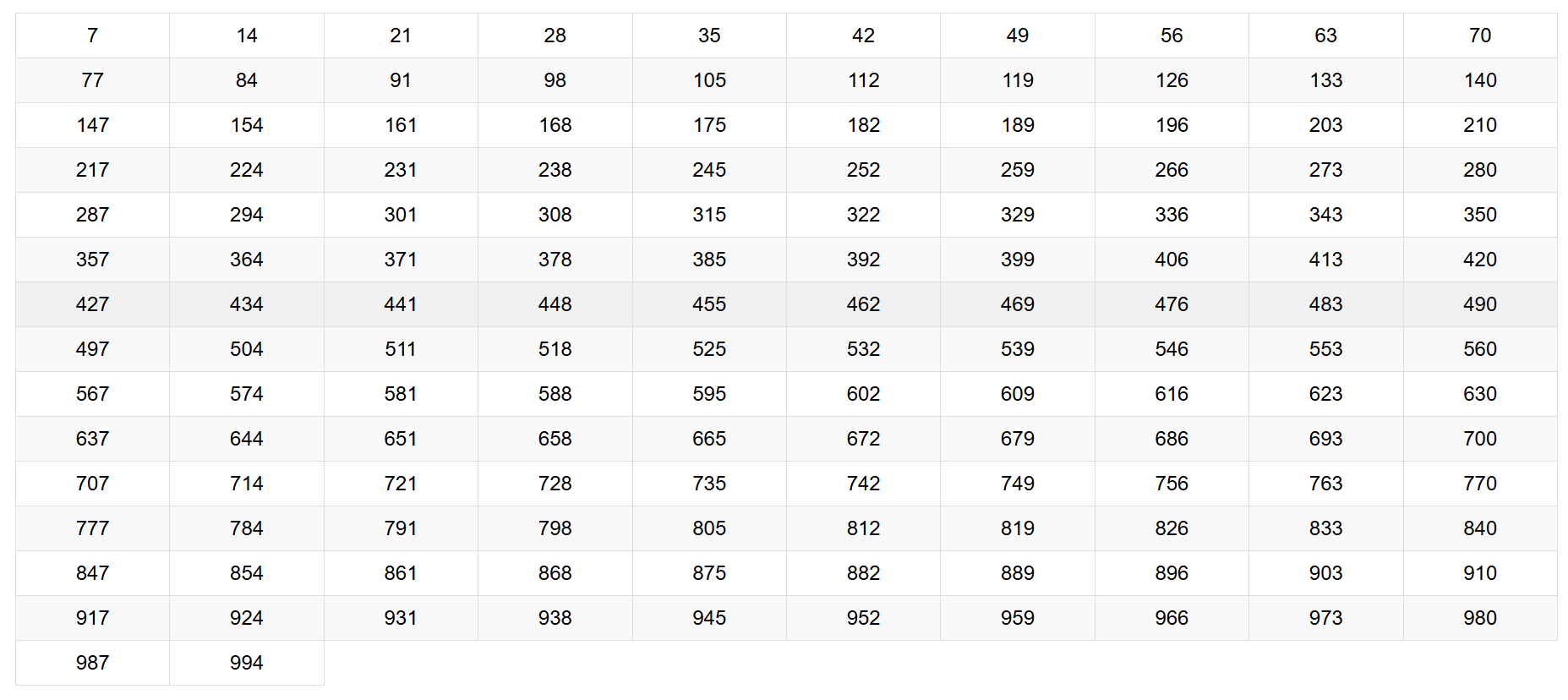
How many Multiples of 7 are there between 100 and 1000?
To find out how many multiples of 7 there are between 100 and 1000, we can follow these steps:
- Step 1. Identifying the smallest multiple of 7 greater than or equal to 100: 100 ÷ 7 ≈ 15
Rounding upwards gives 15, so the smallest multiple of 7 is: 15 x 7 = 105
- Step 2. Identifying the largest multiple of 7 less than or equal to 1000: 1000 ÷ 7 ≈ 142
Rounding down gives 142, so the largest multiple of 7 is: 142 x 7 = 994
- Step 3. Counting numbers of the multiples of 7 from 105 to 994: 105, 112, 119, 126, 133, 140, …, 994
The common difference of this sequence of numbers is 7, the first term is 105 and the last is 994. The method for finding the number of terms: n = (994-105) ÷ 7 + 1 = 128
Thus, there are 128 multiples of 7 between 100 and 1000.
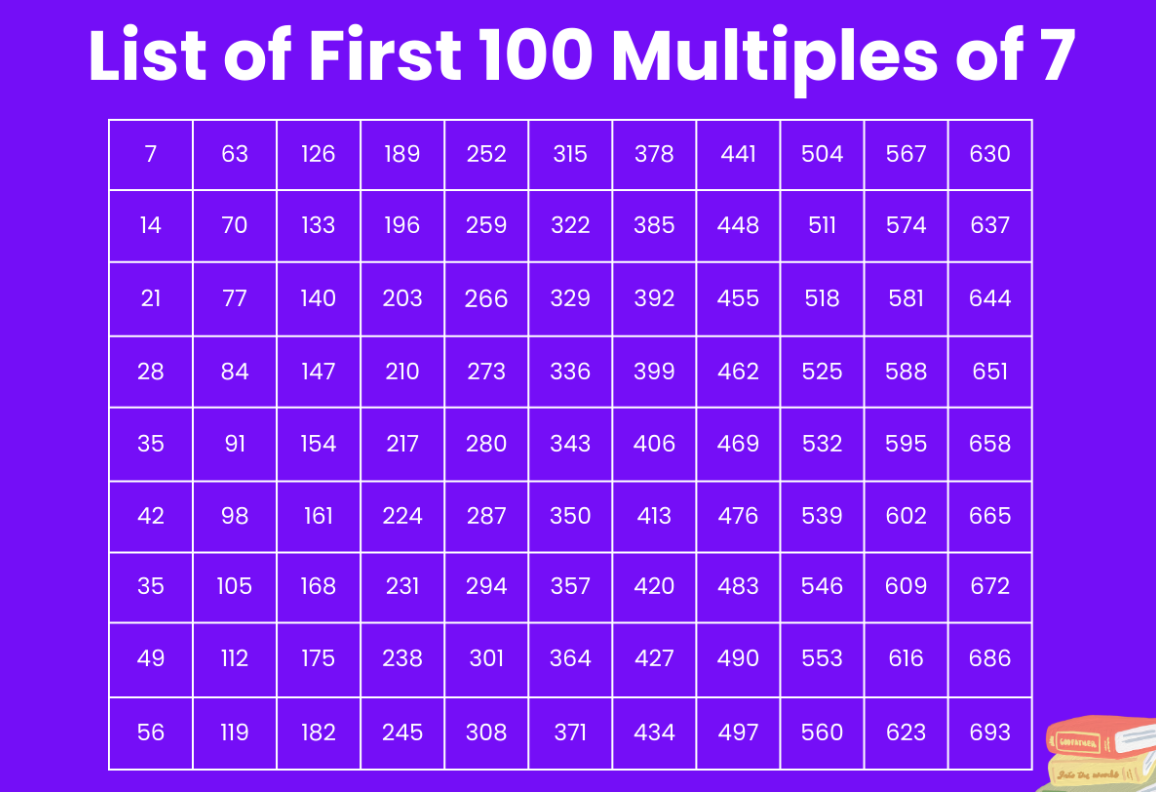
What are the Least Common Multiples of 7?
The least common multiples (LCM) of a single number, such as 7, is simply the number itself. Since 7 is a prime number, its LCM with any other number is simply the product of 7 and that number. Therefore the least common multiple of 7 with itself is 7, and for any other number n, the LCM of 7 and n is 7 x n.
If you are looking for the least common multiples of 7 with other numbers, here are a few examples:
- LCM(7, 1) = 7
- LCM(7, 2) = 14
- LCM(7, 3) = 21
- LCM(7, 4) = 28
- LCM(7, 5) = 35
- LCM(7, 6) = 42
- LCM(7, 8) = 56
- LCM(7, 9) = 63
- LCM(7, 10) = 70
And so on, with each LCM being a multiple of 7.
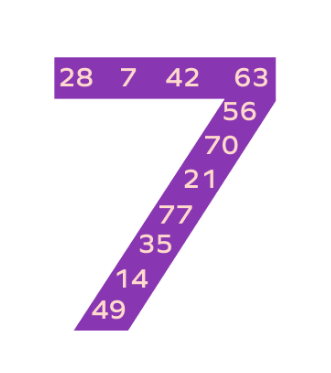
Solved Examples on Multiples of 7
Here are some examples of solved problems that provide answers to common questions about multiples of 7:
Q.1: What is the average of the first ten multiples of 7?
Answer: The average of the first ten multiples of 7 is equal to the sum of all multiples divided by 10.
Average = (7+14+21+28+35+42+49+56+63+70) ÷ 10
= 385 ÷ 10
= 38.5
Therefore, the required average is 38.5.
Q.2: Is 72 a multiple of 7 yes, or no?
Answer: No, 72 is not a 7 multiple. It is not multiple, as when divided by 7, it will leave a remainder of 2.
Q.3: What are the multiples of 7 that are less than 40?
Answer: The multiples of natural number 7, which are less than 40 are 7, 14, 21, 28, 35.
Q.4: What is the least common multiple of 6 and 7?
Answer: To find the least common multiple of 6 and 7, first we will write the multiples of each of the numbers.
- Multiples of 6 = 6, 12, 18, 24, 30, 36, 42, 48, 54, 60.
- Multiples of 7 = 7, 14, 21, 28, 35, 42, 49, 56, 63, 70
Therefore, we can see, the LCM of 6 and 7 is 42.
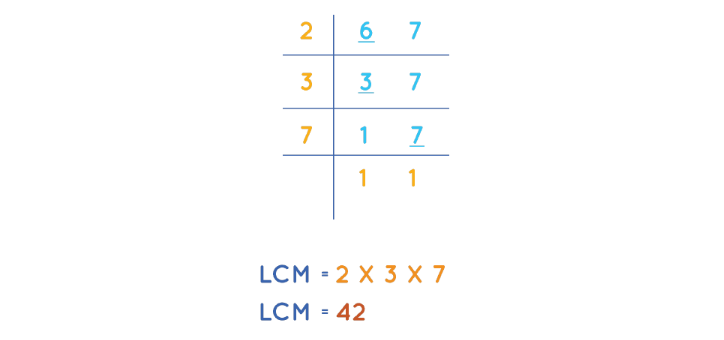
FAQs on Multiples of 7
1.How to find multiples of a number?
To find the multiples of a number, you can simply multiply that number by different natural numbers. Here’s how you can do it:
- Start with the number itself. For example, if you are finding the multiples of 9, start with 9 x 1 = 9
- Multiply the number by successive natural numbers (1, 2, 3, 4, 5, etc. …) to get more multiples.
For example, to find the first few multiples of 9:
- 9 x 1 = 9
- 9 x 2 = 18
- 9 x 3 = 27
- 9 x 4 = 36
- 9 x 5 = 45
You can apply this same process to any number, and the multiples of a number are always evenly divisible by that number.
2.What is the lowest common multiple of 7?
The lowest common multiple (LCM) of 7 is simply 7 itself. This is because 7 is a prime number, and the smallest multiple of any prime number is the number itself.
- LCM(7, 7) = 7
- LCM (7, 1) = 7
In general, the LCM of any number with 7 (or any prime number) will be a multiple of 7, but the smallest LCM involving only 7 is always 7.
3.What are the first three common multiples of 7 and 11?
To find the first three common multiples of 7 and 11, we need to determine the least common multiples (LCM) of 7 and 11 and then list their multiples.
Since 7 and 11 are both prime numbers, their LCM is simply the product of the two numbers:
- LCM(7, 11) = 7 x 11 = 77
The first three common multiples of 7 and 11 are the first three multiples of 77 are:
- 77 x 1 = 77
- 77 x 2 = 154
- 77 x 3 = 231
So, the first three common multiples of 7 and 11 are: 77, 154, 231.
Conclusion
In this article, we explore the concept of multiples of 7 and provide detailed examples, including how to find multiples in a given range. We hope this comprehensive overview will help you better understand the laws of multiples and their applications.
By having this information at your fingertips, you will not only improve your math skills, but also build a solid foundation for solving more advanced math problems. If you’re looking to delve deeper into multiplicative differences or further improve your math skills, consider taking a WuKong Math course. Their structured courses can provide you with the guidance and practice you need to help you progress as well as excel in math.
Discovering the maths whiz in every child,
that’s what we do.
Suitable for students worldwide, from grades 1 to 12.
Get started free!Master’s degree from Yangzhou University. Possessing 10 years of experience in K-12 Chinese language teaching and research, with over 10 published papers in teh field of language and literature. Currently responsible for teh research and production of “WuKong Chinese” major courses, particularly focusing on teh course’s interest, expansiveness, and its impact on students’ thinking development. She also dedicated to helping children acquire a stronger foundation in Chinese language learning, including Chinese characters, phonetics (pinyin), vocabulary, idioms, classic stories, and Chinese culture. Our Chinese language courses for academic advancement aim to provide children with a wealth of noledge and a deeper understanding of Chinese language skills.




![Math League: Competitions, Challenges, and Achievements [2025 Full Guide] Math League: Competitions, Challenges, and Achievements [2025 Full Guide]](https://wp-more.wukongedu.net/blog/wp-content/uploads/2024/01/school-2353406-520x293.jpg)


![7 Ways About How to Say F You in Chinese [With Pinyin] 7 Ways About How to Say F You in Chinese [With Pinyin]](https://wp-more.wukongedu.net/blog/wp-content/uploads/2024/02/image-52-520x293.png)


Comments0
Comments